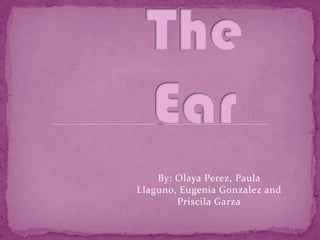
The ear
- 1. By: Olaya Perez, Paula Llaguno, Eugenia Gonzalez and Priscila Garza
- 2. Is the organ that detects sound. It not only receives sound, but also aids in balance and body position. It contains the outer ear, the middle ear and inner ear.
- 4. The outer ear does help get sound but the ear canal is very important. Unless the canal is open, hearing will be dampened. Ear wax is produced by glands in the skin of the outer portion of the ear canal. The outer ear ends at the most superficial layer of the tympanic membrane. The tympanic membrane is commonly called the ear drum.
- 5. The middle ear, an air-filled cavity behind the ear drum (tympanic membrane), includes the three ear bones: the malleus or hammer, incus or anvil, and stapes. The arrangement of the tympanic membrane and bones works to couple the sound from the opening of the ear canal to the cochlea.
- 6. The inner ear includes both the organ of hearing, the cochlea, and a sense organ that is attuned to the effects of both gravity and motion. The inner ear is encased in the hardest bone of the body. Three fluid filled spaces: the scala tympani, the scala vestibuli and the scala media.
- 7. When something makes a noise, it sends vibrations, or sound waves, through the air. When the sound waves hit your eardrum, it vibrates and the brain interprets these vibrations as sound. Your eardrum, which is smaller and thinner than the nail on your pinky finger, sends the vibrations to the three smallest bones in your body. First the hammer, then the anvil, and finally, the stirrup. The stirrup passes those vibrations along a coiled tub in the inner ear called the cochlea.
- 8. Inside the cochlea there are thousands of hair-like nerve endings, cilia. When the Cochlea vibrates, the cilia move. Your brain is sent these messages through the auditory nerve. Your brain then translates all that and tells you what you are hearing.
- 9. Falls, blows to the head, sports injuries, and even listening to loud music can cause ear damage, which can affect hearing and balance. Hearing loss and balance problems can happen when there's damage to key parts of the ear, like the eardrum, ear canal, bones, cochlea, or the vestibular nerve.
- 10. Earwax blockage, can prevent your ears from conducting sounds as well as they should. According to the National Institutes of Health, an estimated one-third of people in the United States between the ages of 65 and 75 and close to one-half of those older than 75 have some degree of hearing loss.
- 11. Cuts, scrapes, burns, or frostbite. When there's an injury to the outer ear or ear canal, bleeding and infection can affect other parts of the ear. You can prevent it by cleaning the cut regularly. Inserting something into the ear. Things like a cotton swab, fingernail, or pencil can scratch the ear canal or cause a tear or hole in the eardrum, called a ruptured eardrum. You can prevent it by not putting things in your ears. Direct blows to the ear or head. This type of injuries can develop severe bruising or blood clots that block blood flow to the cartilage of the outer ear and damage its shape and structure. You can prevent it by protecting your head/
- 12. Loud noise. When this happens, the tiny hairs in the cochlea become damaged. You can prevent it by not be around them or if you really have to, wear some ear plugs. Sudden, significant change in air pressure. Air pressure decreases as we go higher and increases as we go lower. If the pressure isn't equalized, the higher air pressure pushes on one side of the eardrum and causes pain and sometimes partial hearing loss, called barotrauma.